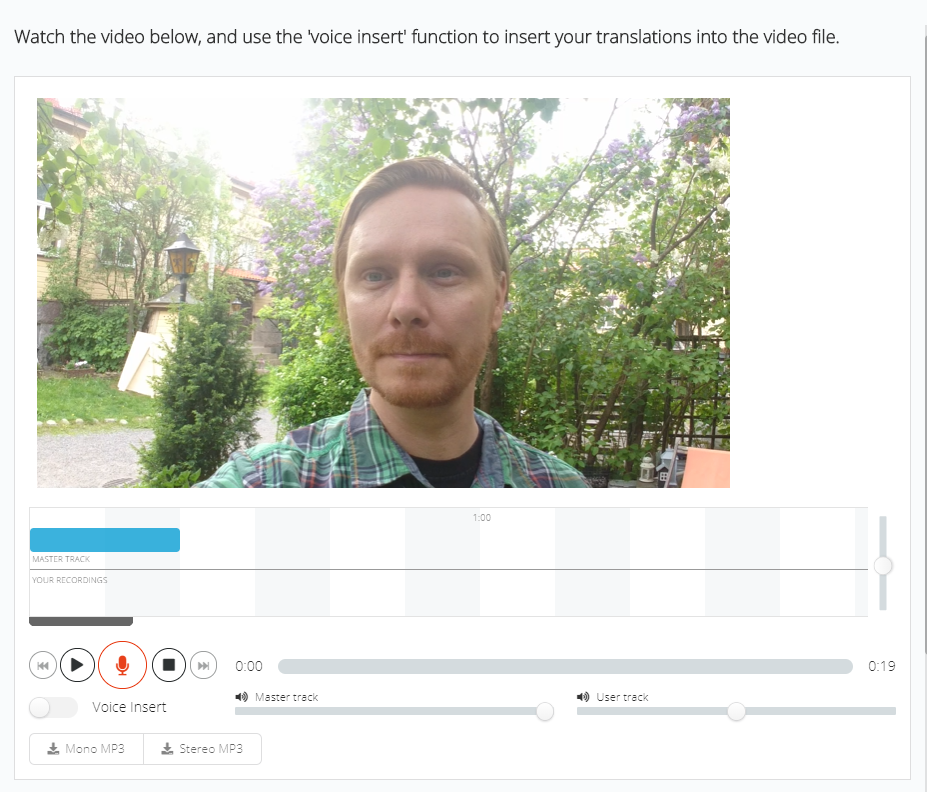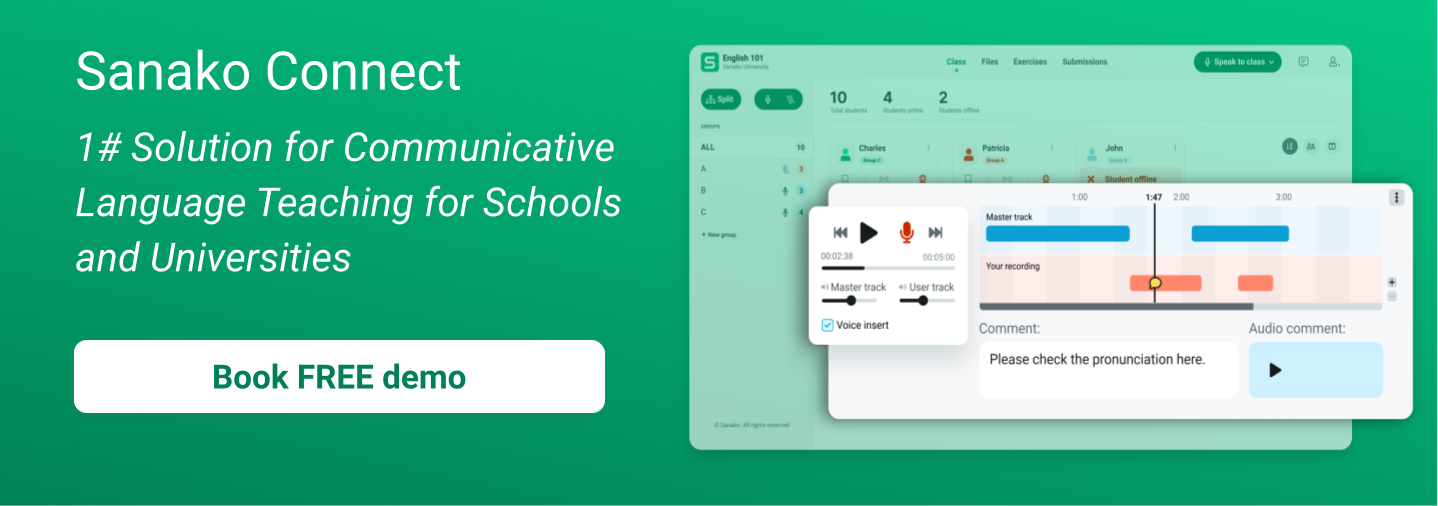In common with the rest of education, language teaching and learning have been significantly impacted by the Covid-19 pandemic and the rapid deployment of educational technology (EdTech). Of course, these changes have created some challenges but they’ve also opened up new opportunities for students to improve their core language skills.
The increasingly widespread availability of fast, reliable internet connectivity has allowed educators to vary both the mode of content delivery (face-to-face, online / distance or hybrid) and how / when students are expected to attend classes and complete their work. Whilst the benefits of synchronous delivery have been widely discussed and are perhaps more evident, learning asynchronously can also deliver significant benefits to your students. This blog post explores how enabling students to work asynchronously can improve their confidence and fluency when speaking the target language.
Asynchronous vs. synchronous language teaching
There are two main modes of teaching / learning when being delivered online or at a distance – these are known as synchronous and asynchronous modes.
Synchronous online teaching typically occurs when students situated in a remote location simultaneously connect and enjoy a language lesson with their teacher and other students through an online platform or mobile application. This mode is delivered in real-time and requires student(s) and teacher(s) to be present throughout the lesson.
On the other hand, asynchronous teaching is ‘individually-based’ (Bernard et al 2004) and highly flexible. It can happen at the time and location that best suits each individual student. The student works through the resources set by the educator for each assignment / lesson at their own pace, in their own time whilst under the teacher’s supervision.
For further detail on the differences between the two models, please visit our other blog post on the topic.
What are the advantages of asynchronous delivery?
Writing before the pandemic in 2008, Hrastinski identifies a number of key advantages to asynchronous delivery for educators and students. They are principally related to the increased number and variety of opportunities for learning and reflection. This allows students more time to process the lesson information being presented.
Learning asynchronously also puts students at the heart of their own learning process. They are responsible for making sure that they do the work in the time allowed, but have flexibility about when they actually get it done. This approach can also be highly convenient for some students, particularly those with work or family commitments or with long travel times to get to school. The approach also works well with introverted or less-confident students, who have challenges overcoming some of the social obstacles to learning and speaking.
As such, asynchronous learning is particularly relevant for language students. The applications for listening, reading and writing are obvious, but there’s an increasing case for using asynchronous delivery to build and develop students’ speaking skills.
Why asynchronous speaking practice is important?
Building asynchronous speaking exercises and practice into your lesson plans is an excellent option for all educators to consider, however their courses are being delivered.
As a recent CUP blog post on the topic suggests, they deliver numerous benefits for language learners.
- Most importantly they offer “….a chance to increase the quantity (and sometimes the quality) of oral language practice.” Ultimately, the aim of every language educator is to maximise the amount of time each student spends actively using the language and asynchronous exercises take this to the next level!
- There’s an increasing evidence base highlighting their effectiveness and impact. Jarmillo 2021, for example, identified that such exercises can “… promote the development of confidence to use the foreign and second language more spontaneously, while allowing students to fail without being judged or penalised.“
- Asynchronous speaking tasks allow students to practice “prepared, rather than spontaneous, speech.”
- By targeting “presentational, as opposed to interpersonal, speaking,” students can use asynchronous exercises to build new skills and use the longer speaking turns to build confidence and fluency. Learners can also develop the all-important muscle memory that underpins so much of L2 speaking success.
- Students are able to work anytime, anywhere and on any device that they have, as long as there’s good quality internet connection.
- Learners can use their time to prepare and revise their spoken responses. This could offer “similar benefits to the process of task repetition in synchronous contexts.”
- Asynchronous tasks are accessible for all learners – delivering a response in the comfort of your own home will, for example, be far more appealing to many students than doing it in front of their peers in class!
- They’re also perfectly suited to common speaking exercises such as image description and “repeat after me.” Both of which can be easily completed by students remotely and in their own time.
- As all of your students’ contributions are recorded, they can be an invaluable resource for assessing the progress that they’re making. They also give students the chance to self-evaluate their work and potentially those of their peers.
What is a good asynchronous speaking exercise?
Ultimately, as outlined above, the key element of a successful asynchronous speaking exercise is that it maximises students’ opportunities to practise their speaking skills. This clearly applies to presentational speaking tasks as outlined above but any exercise that gets students talking would also be of value. The key is simply to produce some / more spoken language!
Students could therefore:
- Address an imaginary audience on a topic that impacts or interests them (e.g. longer lunch breaks, no phones in schools, climate change, etc.)
- Record a response to a text, image or piece of audio / video content provided by the teacher. This could either stimulate a creative response or simply mirror the speech that they have heard.
- Follow-up and extend grammar and vocabulary learning to demonstrate that they know how to say and use the concepts and words appropriately.
- Act out a role-play by pretending to be a TV anchor, Audio book narrator or a podcaster.
Aside from the production of language, a good asynchronous exercise also gives the student the chance to reflect and review their work. Students should also consider how it could be improved in the light of feedback from the teacher. Given that exercises are always digitally recorded, it is easy for language teachers to feedback to the individual student or the whole class.
As students are learning remotely for some or all of their classes, feedback (in any form) is vital to maintain their engagement and to inspire their further progress. Feedback can also be used to encourage further contributions on this and other topics.
Below is a screencapture from Sanako Connect. Teachers can create asynchronous speaking assignments with a click of a button and share them for their students. Students can use the Voice Insert function to add their responses on a second audio track which makes it very easy for the teacher to review students’ work and add time-coded feecback on individual student’s recordings.

How to deliver asynchronous speaking tasks?
Evidently, creating, sharing and completing asynchronous speaking exercises requires consistent internet access. Although tasks can be completed by using a combination of different, generic audio and video-conferencing tools, educators increasingly prefer using a dedicated and specialist online language learning platform for the task.
Tools like Sanako Connect offer a blended teaching platform that combines the best parts of virtual classroom solutions and dedicated language teaching platforms. Connect has also been specifically designed to help language educators improve students’ speaking skills, in both asynchronous or asynchronous settings. It enables teachers to:
- Create engaging speaking exercises using a wide variety of media including sound files, images, presentations, videos and other digital content.
- The teacher can also record stimulus material and students can record their responses at the click of a button. All content is electronically stored on the same platform and can be easily retrieved and reviewed.
- Assign specific exercises to specific students to demonstrate their language fluency. Learning resources can be clearly differentiated and personalised to individual students.
- Give students access to the exercises / resources from any location with internet access, at any time and using any device, including laptops, Chromebooks, tablets or smartphones.
- Provide detailed feedback via Connect’s two-track feedback functionality. Students can immediately see where improvements need to be made. They can then relisten to the original audio material and record additional attempts.
If you’d like to find out how Sanako Connect could help you deliver asynchronous speaking exercises and transform your students’ speaking skills, please contact us now to arrange your FREE demo!

